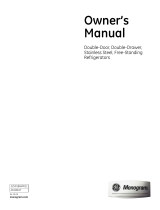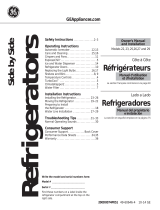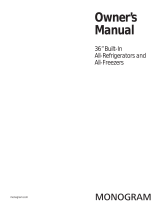
Care and cleaning of the refrigerator. GEAppliances.com
Cleaning the Inside
To help prevent odors, leave an open box of baking
soda in the refrigerator and freezer compartments.
Unplug the refrigerator before cleaning. If this is
not practical, wring excess moisture out of sponge
or cloth when cleaning around switches, lights or
controls.
8VHZDUPZDWHUDQGEDNLQJVRGDVROXWLRQ³DERXW
a tablespoon (15 ml) of baking soda
to a quart (1 l) of water. This both cleans and
neutralizes odors. Rinse and wipe dry.
After cleaning the door gaskets, apply a thin layer
of petroleum jelly to the door gaskets
at the hinge side. This helps keep the gaskets from
sticking and bending out of shape.
Drain opening in freezer compartment. During
yearly cleaning, remove bottom freezer pan and
IOXVKDVROXWLRQRIEDNLQJVRGD³WHDVSRRQPO
DQGFXSVPORIKRWQRWERLOLQJZDWHU³
through the drain line with the help of a meat
baster. This will help eliminate odor and reduce the
likelihood of a clogged drain line. If drain becomes
clogged, use a meat baster and baking soda
solution to force the clog through the drain line.
Avoid cleaning cold glass shelves with hot water
because the extreme temperature difference may
cause them to break. Handle glass shelves carefully.
Bumping tempered glass can cause it to shatter.
Do not wash any plastic refrigerator parts in the
dishwasher.
Behind the Refrigerator
Be careful when moving the refrigerator away from the wall. All
types of floor coverings can be damaged, particularly cushioned
coverings and those with embossed surfaces.
Pull the refrigerator straight out and return it to position
by pushing it straight in. Moving the refrigerator in a side
direction may result in damage to the floor covering or
refrigerator.
When pushing the refrigerator back, make sure you don’t
roll over the power cord or icemaker supply line (on some
models).
For long vacations or absences, remove food and unplug the
refrigerator. Clean the interior with a baking soda solution of
one tablespoon (15 ml) of baking soda to one quart (1 l) of water.
Leave the doors open.
Slide the icemaker power switch to the OFF position and shut
off the water supply to the refrigerator.
Preparing for Vacation
Preparing to Move
Secure all loose items such as grille, shelves and drawers by taping them securely in place to prevent damage.
Be sure the refrigerator stays in an upright position during moving.
NOTE: Turning the refrigerator to the 0 (off) setting via the controls does not shut off electrical power to the refrigerator.
Replacing the Light Bulbs
Unplug the refrigerator.
Remove the shelf just below the light shield.
Replace with an appliance bulb of the same or lower
wattage.
Reinstall the shelf and plug the refrigerator back in.
9
Cleaning the Outside
The dispenser drip area, (on some models) beneath the
grille, should be wiped dry. Water left in this area may
leave deposits. Remove the deposits by adding undiluted
vinegar to the well. Soak until the deposits disappear or
become loose enough to rinse away.
The dispenser cradle (on some models). Before
cleaning, lock the dispenser by pressing and holding
the Lock pad for 3 seconds. Clean with warm water
DQGEDNLQJVRGDVROXWLRQ³DERXWDWDEOHVSRRQ
ml) of baking soda to a quart (1 l) of water. Rinse
thoroughly and wipe dry.
The door handles and trim. Clean with a cloth dampened
with soapy water. Dry with a soft cloth.
Keep the outside clean. Wipe with a clean cloth
lightly dampened with kitchen appliance wax or mild
liquid dish detergent. Dry and polish with a clean,
soft cloth.
The stainless steel door panels and handles.
The stainless steel panels can be cleaned with a
commercially available stainless steel cleaner or a
similar product using a clean, soft cloth. Do not use
appliance wax, polish, bleach or products containing
chlorine on stainless steel doors and handles.
For best results, GE recommends using stainless
steel cleaner PM10X311 with the WX10X307
polishing cloth, or for convenience the SS cleaning
wipes, part number WX10X10001.
Do not wipe the refrigerator with a soiled dish cloth
or wet towel. These may leave a residue that can
erode the paint. Do not use scouring pads, powdered
cleaners, bleach or cleaners containing bleach because
these products can scratch and weaken the paint
finish.





















